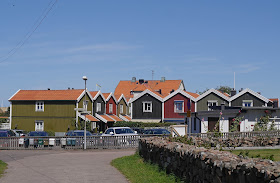The Turning Torso
Malmö is the last port of call on our tour of southern Sweden. There is no town trail, but a helpful young advisor in the Tourist Office near the main railway station gave us a rough circular route. We headed off across a large area of old docks and new buildings towards the wonderful Turning Torso. This extraordinary building by Santiago Calatrava is already ten years old, but remains, at 190m, the tallest in Scandinavia. It was apparently based in a sculpture by the architect.
The view above is the one usually photographed, but the route we took approached the building from behind, from where the supporting structure was more evident. We just loved it.
Part of its function was to replace a giant crane which once dominated the Malmö skyline and to act as a new symbol for the town as it shook off its industrial past.
Just beyond the Turning Torso is a viewpoint towards another constructional marvel: the Öresund Bridge.
The Bridge (as it will ever be known, thanks to the Danish-Swedish crime
series) stretches nearly 8 kilometres from the Swedish coast to an
artificial island (Peberholm) which lies in the middle of the Öresund
strait.This in turn leads to a 4 km underwater tunnel to the Danish
island of Amager. It opened in 2000.
We followed a very pleasant walkway along the shoreline and continued in a clockwise direction towards the city centre eventually reaching the Malmöhus, a rather strange-looking 15th century castle, which now houses a museum, having earlier declined into use as a prison and then grain store. The two red structures do indeed look like grain silos, but were built as keeps.
We were delighted to see that a tram route connects the castle to the city.
We headed onwards towards the centre and reached the area of old houses we had been told about. There were some lovely houses in Jakob Nilsgatan. Firstly, this 1900-ish red brick one with art nouveau details.
And further along the street were the same sort of traditional single-storey houses with flowers outside that we had seen in Lund.
We turned right into Ostindiefarataregatan where we spotted (we could hardly miss it) this wonderful red brick and terracotta house with floral motifs.
We were now on the edge of Lilla Torget, a small square built in the 16th century on one corner of the main square, Stortorget, where we had parked our hire car. (Where else but Sweden could you just drive into a city's main square and park?) There were some nice old timbered houses along one side.
When we reached Stortorget we found it full of people - a Gay Pride march which was about to depart. We were a shade anxious that we might not be able to get the car out and drive to Copenhagen airport in time for our flight home, but we decided to distract ourselves by a visit to St Petri Kyrka, the oldest church in the city. We returned to Lilla Torget and walked along to Ostergarten to enter Stortorget from the other corner. This brought us past this lovely art nouveau gem.
As we reached Stortorget again the last vehicles and marchers were starting to leave so we could relax.
We walked past the superb Town Hall (Radhus) of 1546. We even liked the Dutch Renaissance style exterior which was added in a 19th century restoration.
St Petri Kyrka lay more or less behind the Radhus and was a fine red brick building with the stepped gable of the kind we have become familiar with over the last few days. Inside, it is completely white, having been whitewashed in 1553 during the Reformation to expunge all the distracting fescoes.
Happily, a few remain in one side chapel, and very lovely they are.
Conditions: grey and drizzly at first, becoming gradually brighter.
Distance: about three miles.
Rating: five stars.





















































